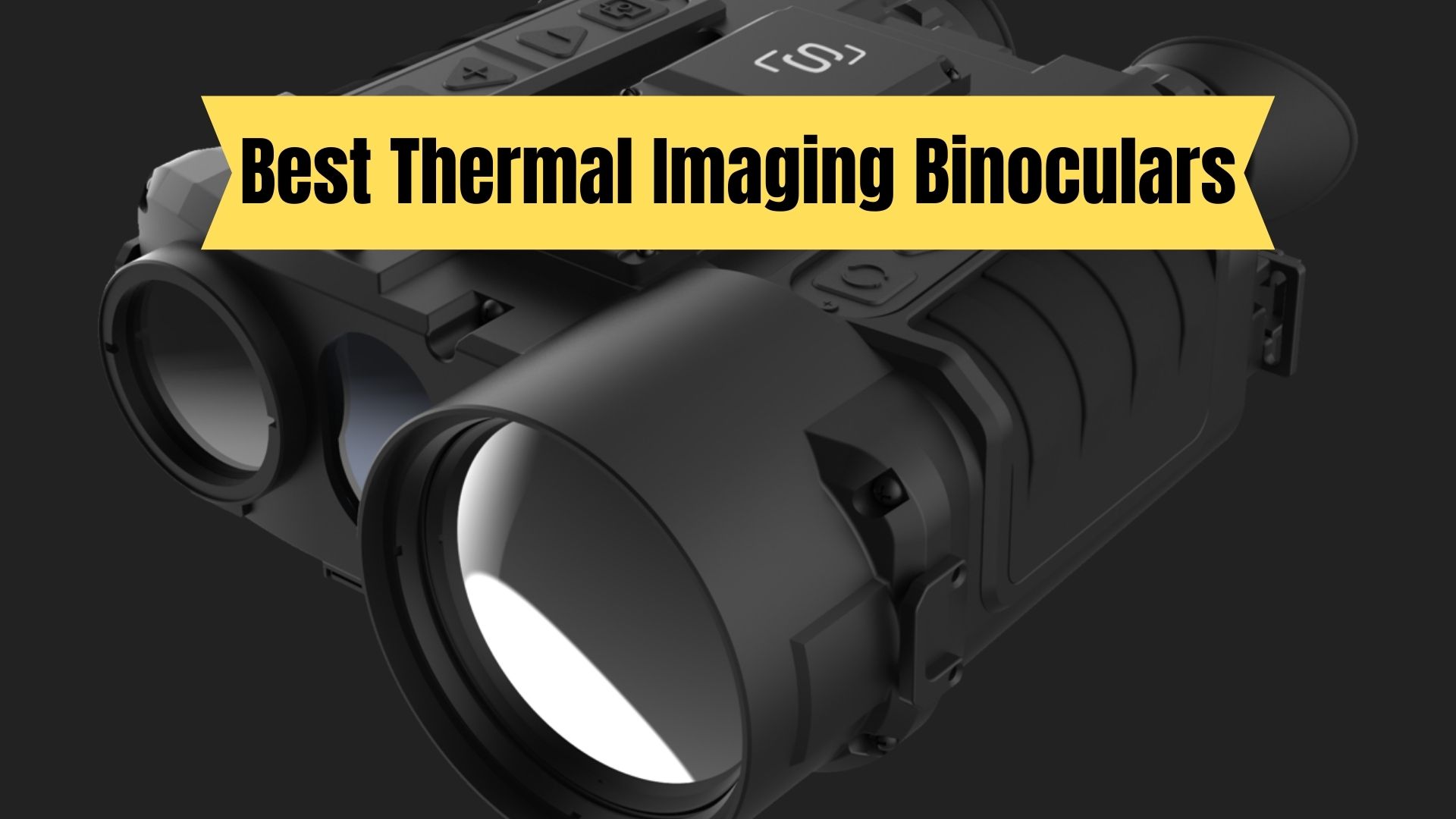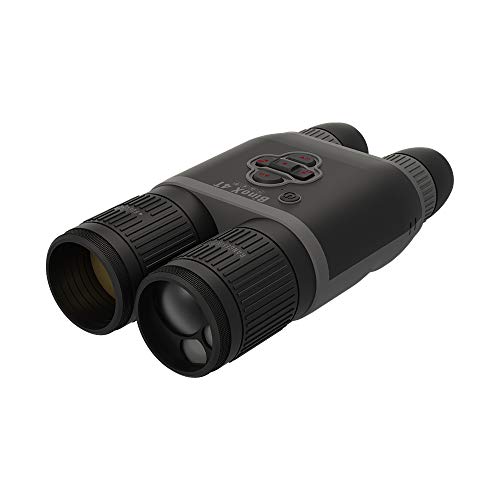Best Thermal Imaging Binoculars 2024
Are you in search of best thermal-imaging binoculars?
This guide will assist you in making a wise investment decision.
Here we will provide you with the necessary information to find the best pick at the most competitive price."
How Thermal Binoculars are Different Than Normal Binoculars
These binoculars use infrared technology to create images from the heat signatures emitted by objects, allowing users to see in complete darkness and through smoke, fog, and other obstructions.
How Thermal Binoculars Work
Thermal binoculars work by capturing and interpreting the infrared light emitted by objects in view.
The process begins with a special lens that focuses the infrared light onto a phased array of infrared detector elements.
These elements create a highly detailed temperature pattern, known as a thermogram, in just a fraction of a second by collecting temperature information from thousands of points within the field of view.
Next, the thermogram is translated into electric impulses, which are sent to a signal-processing unit.
This circuit board houses a dedicated chip that converts the data from the elements into a format suitable for display.
Finally, the processed information is displayed, appearing as various colors depending on the intensity of the infrared emission. By combining the impulses from all of the detector elements, a full thermal image is created.
In these binoculars, colder parts of a living being appear blue, while warmer parts appear yellow, orange, and red, creating a distinctive heat signature.
They are completely different from night vision binoculars and goggles.
Major Players In Thermal Imaging Binoculars
When it comes to thermal imaging, there are a few major players in the game.
1. ATN is one of the top manufacturers and offers well-known devices such as the ThOR-HD Thermal Scope, BINOX-THD Thermal Binoculars, and OTS-HD Thermal Monocular.
2. FLIR/Armasight, the largest producer of consumer-level thermal products, is well known for their extensive product line. This includes the Zeus Thermal Scopes, Q14 and Scout Monoculars, Helios and Scout Binoculars, and many more.
3. Pulsar is another popular brand, especially for digital night vision and thermal imaging. Their key products include the Pulsar Trail and Apex Thermal Scopes and the Pulsar Helion and Quantum Thermal Monoculars.
4. AGM -AGM Global Vision brings you high quality electro optics at an affordable price. They have an extensive range of rifle scopes, monoculars, goggles, lasers, infrared illumination devices AGM Global Vision are also popular in night vision and thermal technology industry among enthusiasts.
"Thermal imaging binoculars are a specialized tool, so it's not unexpected that they cost more than regular binoculars due to their niche market."
With a variety of options on the market, it can be difficult to choose the best thermal imaging binoculars.
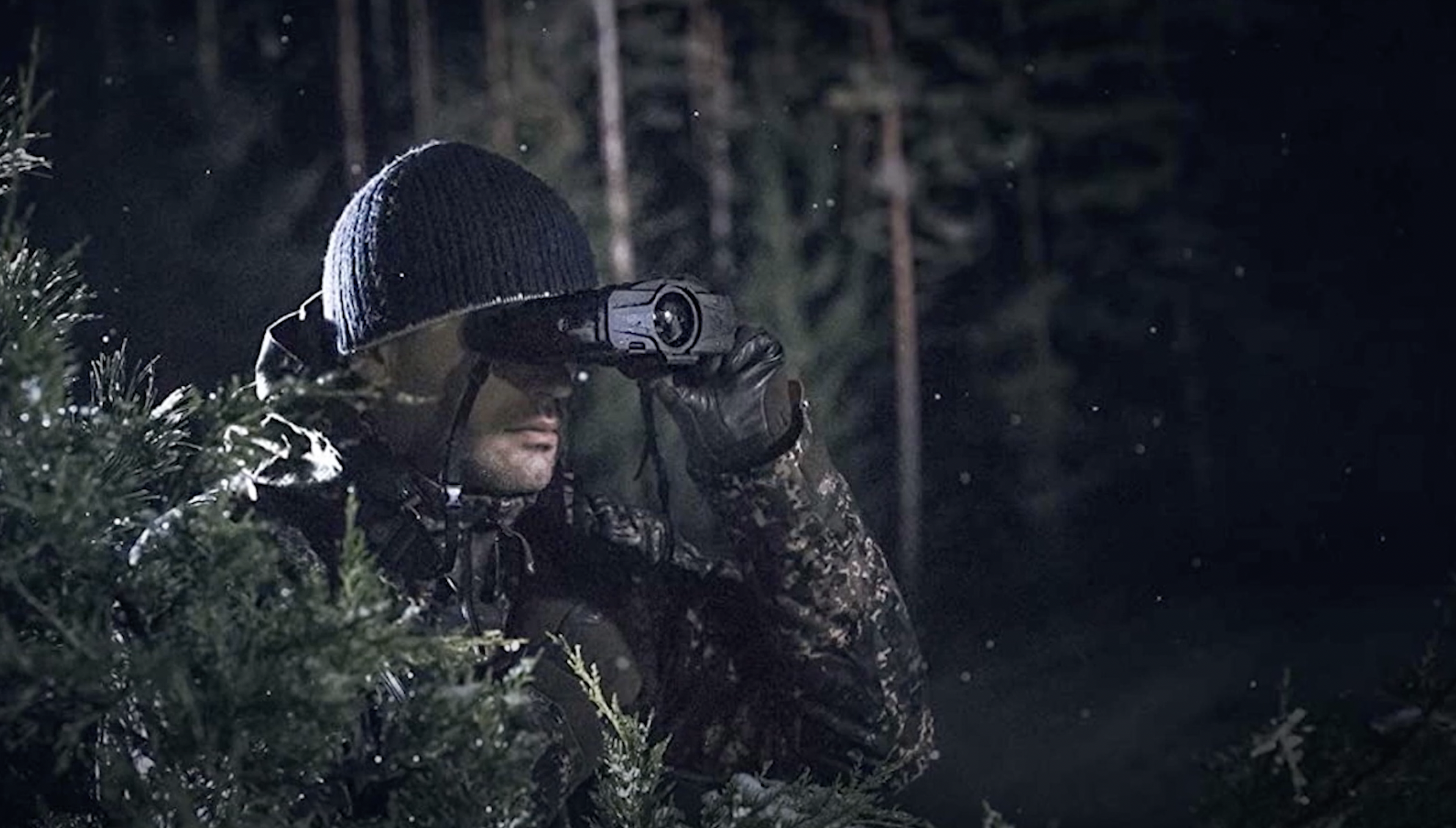
We will review some of the top models available, taking into consideration factors such as image quality, detection range, battery life, and ease of use
A Quick List Of The Best Thermal Binoculars For Hunting & Other Activities
Pulsar accolade XP 50 Pro(Accolade 2)- Best Overall
ATN BinoX 4T 2.5-25x Thermal Binocular-Editor's Choice
AGM Global Vision Model Explorator FSB50-640 - Premium Choice
ATN BinoX 4T 384 4.5-18x Thermal Binocular with Laser Rangefinder
ATN BinoX 4T 384 2-8x Thermal Binocular with Laser Rangefinder
Pulsar Thermal Imaging Binoculars Merger LRF XP50
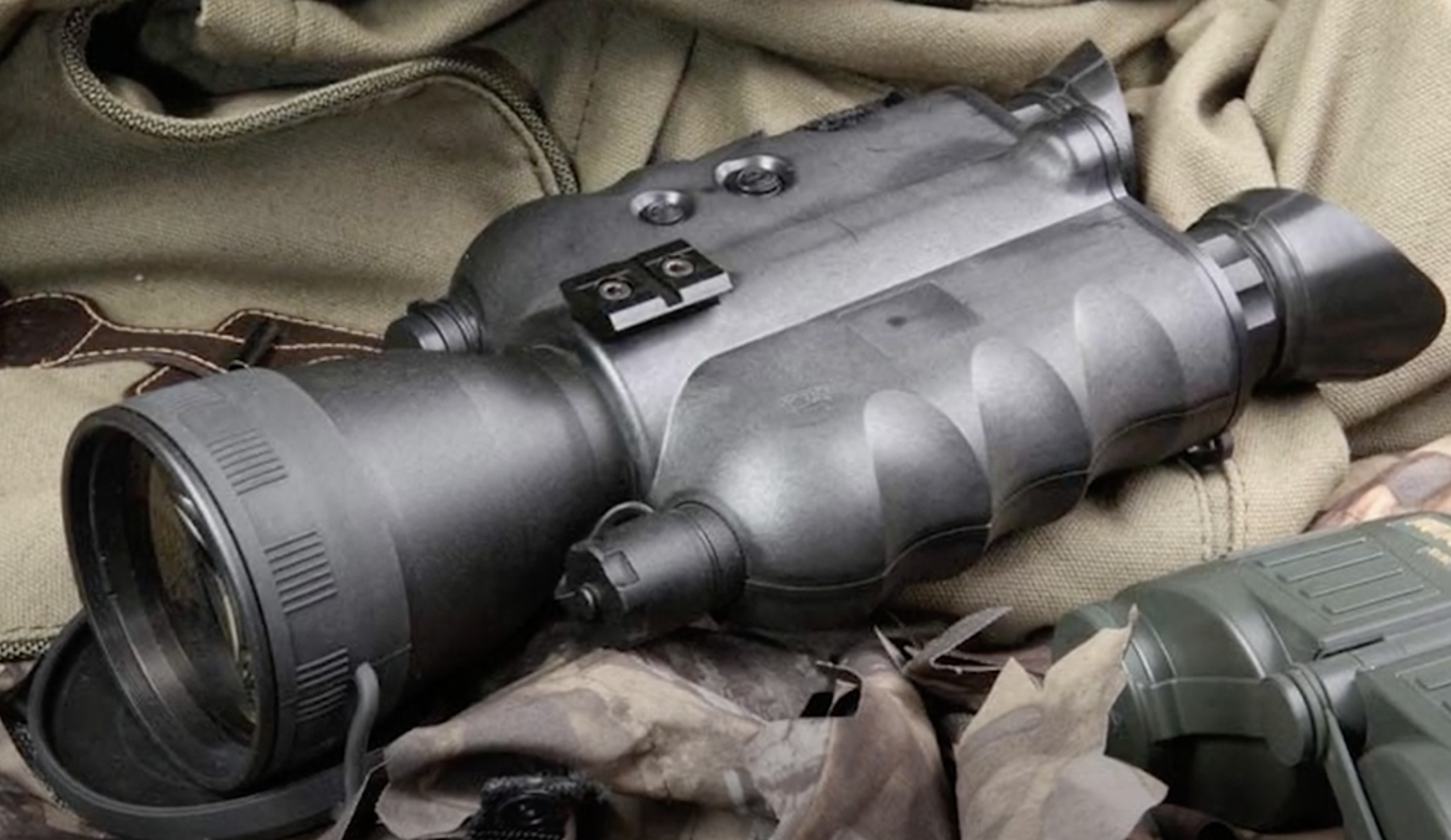
Best Thermal Binoculars-Our Top Picks & Reviews In 2024
Now, Without any delay let me share you the best thermal binoculars in 2024.
Pulsar accolade XP 50 Pro(Accolade 2)-Best Overall
The Accolade thermal binoculars are versatile and suitable for both professional and semi-professional uses, such as hunting and scouting, law enforcement, and search and rescue missions.
These binoculars, designed by PULSAR, come equipped with innovative features, including a built-in video recorder, a stadiametric rangefinder, Wi-Fi connectivity, and a quick-change battery for extended use.
The Accolade XP50 Pro model features high-quality thermal imaging sensors with resolutions of 640x480 and 384x288, and a 17 µm pixel pitch, which allows for the production of highly detailed images at a fast 50 frames per second, even in complete darkness.
Key Features
- Highly Sensitive Thermal Imaging NETD <25 mK Sensor
- 2000 yd detection range with 4x digital zoom - continuous zoom and 2x, 4x stepped zoom
- Dual eyepiece configuration reduces eye fatigue
- Picture-in-picture digital zoom and Built-in recording
- Smart device connection with stream vision app
- AMOLED Display
- Built-in WiFi and Stream Vision App
- waterproof, dustproof, fogproof performance
- 8-Color viewing palette
- 8-hr rechargeable IPS battery supply
- Lightning fast 50Hz refresh rate
Specifications
- Sensor-640x480 @ 17 µm (NETD <25 mK)
- Objective lens-F50/1.2
- Magnification,-x2.5 − 20 (x8 zoom)
- Field of view (HxV), degrees / m@100m-12.4x9.3 / 21.8x16.3
- Detection range, m-1800
- Highly Sensitive Thermal Imaging NETD <25 mK Sensor
- Dual eyepiece configuration reduces eye fatigue
- 2000 yd detection range with 4x digital zoom - continuous zoom and 2x, 4x stepped zoom
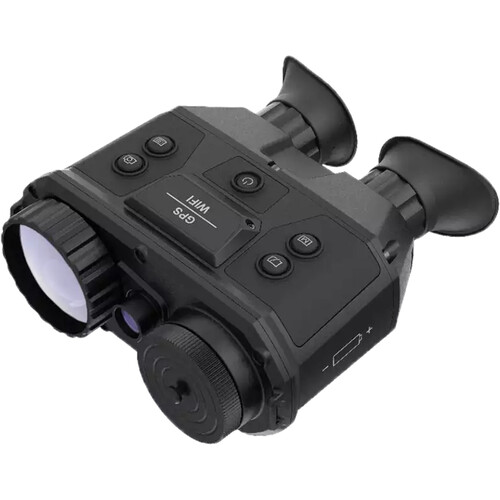
Are you in need of a powerful and reliable bi-spectrum binocular?
Look no further than the AGM Explorator FSB50-640 Handheld Thermal & Optical Bi-spectrum Binocular! This is our second pick for the best thermal imaging binoulars in 2024.
Equipped with an ultra-low light optical detector, a 640×512 thermal detector, a 1024×768 OLED display, and a large field of view eyepieceThis device can quickly detect and locate objects even in extreme environments like smoke, fog, rain, and snow.
With its versatile design, the AGM Explorator is suitable for various scenarios like patrol, law enforcement, search and rescue, drug enforcement, anti-smuggling, and suspect capture.
Let me elaborate the Salient features of AGM Explorator
The thermal imaging unit even offers multiple image palettes, like white hot/black hot, to easily adapt to different conditions.
The unit can be easily mounted on a tripod for convenient, hands-free use. And with the ability to take four 18650 rechargeable Lithium batteries, it offers more than 7 hours of operating time.
Plus, the integrated proximity sensor saves energy by turning the OLED screen on when it detects your eyes and off when not in use. And for even longer operating time, you can use the external power supply (5 V).
The AGM Explorator is waterproof, ensuring top performance in even the most challenging environments. And with its user-friendly interface, comfortable and ergonomic buttons, it's incredibly simple to adopt and use.
SPECIFICATIONS
- Image Sensor-1/3” Progressive Scan CMOS
- Resolution-1280×960 @ 25 fps
- Pixel Pitch-17 μm
- Response waveband-8 μm to 14 μm
- NETD< 40 mk (@25°C, F#=1.0)
- MRAD (IFOV)-0.34
- Field of View-12.42° × 9.95°
- Aperture-F 1.0
- Digital Zoom-4x
- Min. Illumination Level-B/W : 0.001 lux @ (F1.0, AGC On )
- Lens (Focal Length)-12 mm
- Image Enhancement-3D DNR, Adaptive AGC
- Monitor-0.39-inch, OLED, 1024×768
- Thermal/Optical Mode
- Dimension (LxWxH)-6.46” × 7.18" ×2.89"
- Weight-<1.0 kg (2.20 lb)
- Detection Range (6' object)-1470m/yd
ATN Binox 4T 640 2.5-25X- Editor's Choice
The ATN BinoX is a multi-functional device that combines a rangefinder, adjustable power settings, video recording, image capturing, GPS location tracking, and an IR illuminator, making it a comprehensive tool for hunters.
The IR illuminator enhances target visibility when used in conjunction with night vision optics.
The device also features Wi-Fi connectivity, which can be paired with an ATN riflescope through the ATN Ballistic Information Exchange (BIX). This allows for real-time streaming to a paired device, while recording the stream to an SD card stored within the unit.
With the ATN BinoX, hunters can keep track of their hunting partners in the area and have a powerful tool at their disposal for a successful hunt.
Specifications
- Display Resolution 1280x720x2
- Field of View: 12. 5°x9. 7°
- Magnification: 2. 5-25x
- Interpupillary adjustment range 60-70 mm
- Eye relief 10-30 mm
- Focus Range 10 ft - ∞
- Precision to ± 1 y/m
- Range 5-1000 y/m
- Video Record Resolution 1280x960 @ 60 fps
- Battery life (Li-ion) 16+ hrs
- Weight 2.5 lb / 1.12 kg
- Warranty 3 years
- BIX (Ballistic Information Exchange) ATNs SMART HD devices to communicate and exchange information
- Display Resolution: 1280x720x2 / Field of View: 12. 5°x9. 7°
- Magnification: 2. 5-25x / Range: 5-1000y/m
- Video Record Resolution: 1280x720x2 HD Display @ 60fps
ATN BinoX 4T 384 4.5-18x Thermal Binocular with Laser Rangefinder
Are you ready to become an apex predator? With the ATN BinoX-4T 384 4.5-18x Thermal Binocular, no prey is safe!
These thermal imaging binoculars offer a variety of viewing options, including black hot, white hot, and color modes.
You can easily determine the distance to your target using the integrated laser rangefinder, which calculates precise distances day or night.
And the technology doesn't stop there. With the Ballistic Information Exchange (BIX) technology, you can communicate with other smart devices, such as an ATN SMART HD scope. This means that your optic will make calculations for you, saving you time and increasing your accuracy. The Laser Ballistics app also provides precise calculations for your traditional glass scope.
Capture crystal clear videos of your hunts and even stream them to nearby devices via Wi-Fi while still recording onto the internal micro SD card.
Technical Specifications
Manufacturer: | ATN |
Color: | Black |
Battery Life: | 16 hours |
Resolution: | 384x288 pixels |
Magnification: | 4.5 - 18 x |
Objective Lens Diameter: | 50 mm |
Weight: | 2.5 lb |
Magnification Type: | Variable |
Field of View, Angle: | 6x4.7 degrees |
Width: | 128 mm |
Height: | 67 mm |
Focus Range: | 10 ft to infinity |
Length: | 240 mm |
Eye Relief: | 10 - 30 mm |
- Display resolution: 1280x720x2/ field of view: 6°x4. 7°
- Magnification: 4. 5-18X/ range: 5-1000y/M
- Video record resolution: 1280x720x2 HD display @ 60Fps
The BinoX 4T 384 2-8x Thermal Binocular with Laser Rangefinder is the ultimate tool for hunting and outdoor adventures.
With the ability to see heat signatures in the dark, dust, or fog and display them on a 1280 x 720 display in each eyepiece, you'll be able to easily spot your target from a distance of up to 960 yards. With a choice of black hot, white hot, or color modes, you'll be able to choose the display that works best for you.
This versatile optic is equipped with a built-in laser rangefinder that measures distances from 5 to 1000 yards with 1-yard accuracy, and it can even send range information via Bluetooth to a compatible ATN SMART HD riflescope to help determine the point of impact without the need for a holdover.
The built-in infrared illuminator can also assist friends or team members with standard night vision gear.
Capture still images or 1280 x 960 video at 60 fps and save them to a user-supplied microSD card (4 to 64GB).
You can even stream video in real-time to an iOS or Android device running the ATN Obsidian 4 app, where you can save, view, and share your content.
With a runtime of 16 hours on a fresh charge and a 6-hour charge time with a user-supplied 2A adapter, the BinoX 4T is designed to last all day and is weather-resistant to withstand the elements.
Performance
- 2-8x magnification
- Maximum thermal range: detection- 960 yards; recognition- 480 yards; identification- 300 yards
- Built-in IR illuminator for friends/team members with standard NV equipment
- Black hot, white hot & color modes
- 5- to 1000-yard range & ±1 yard accuracy
- Pairs via Bluetooth with ATN SMART HD riflescopes, shares ranging info that eliminates calculations and holdover
- Field of view: 12.0° x 9.5°
Featured Technology
- Built-in Wi-Fi for streaming to iOS or Android device running ATN Obsidian 4 app
- Store photos and video to user-supplied microSD card, 4-16gb card support
- Inbuilt microphone
Construction Details
- Weather-resistant housing
- Broad -20 to 120°F operating temperature range
- Ultra Sensitive Next Gen Sensor With A 60Hz Refresh Rate Provides Long-Range Performance Like Never Before, Helping You...
- Color Modes Displays Moving Objects In Your Preferred Color Settings E.G. Black Hot, White Hot And More
- Built-In Laser Rangefinder Ranges Target Distance Down To A Yard For Precise Measurements Up To A 1000 Yards
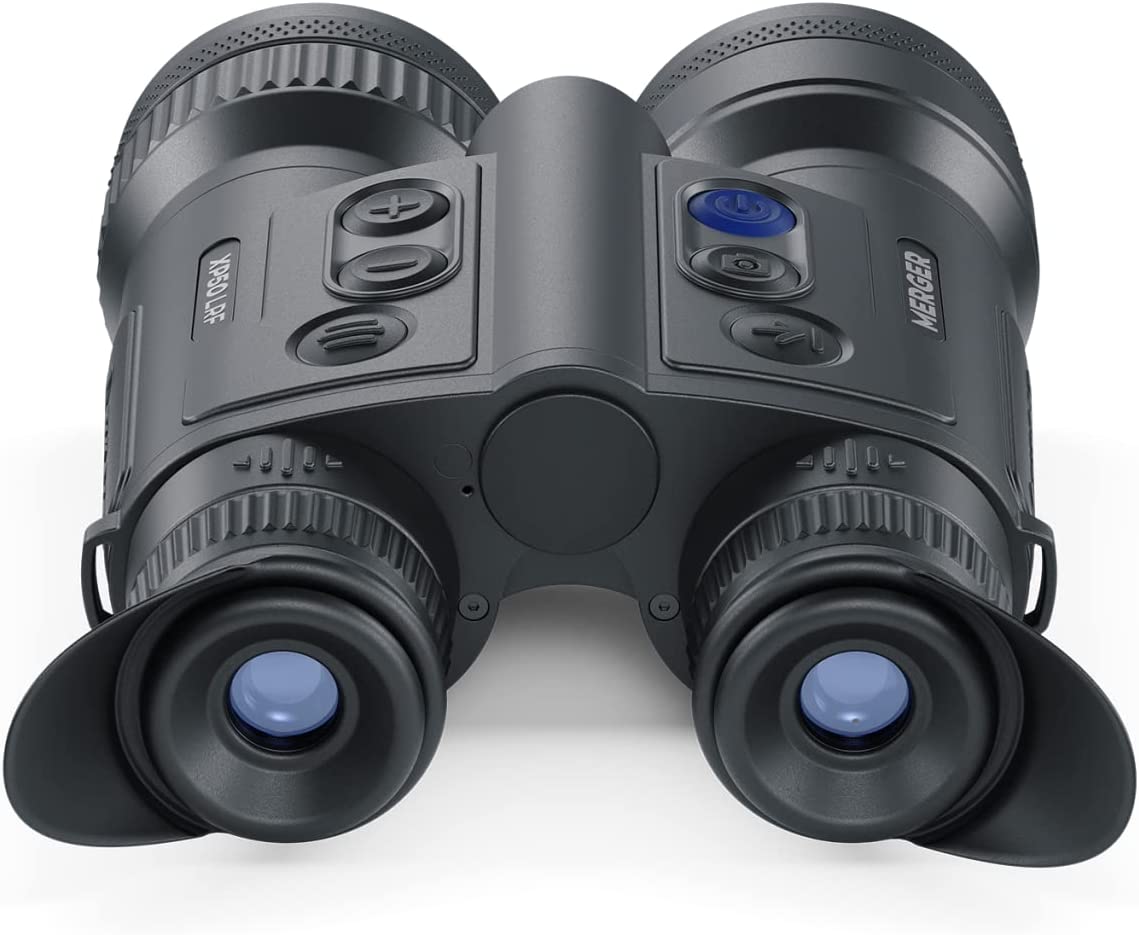
The Pulsar Merger LRF XP50 thermal imaging binoculars are the perfect combination of classic design and cutting-edge technology.
With their compact size and ergonomic form factor, they are comfortable to hold and offer a comfortable viewing experience.
The six function buttons are placed in an accessible zone for easy use, and the interpupillary distance can be adjusted to fit the user's individual needs.
With the ability to detect a standard 6ft tall object from over 1,960 yards away in complete darkness, the Merger fully unlocks the potential of human vision.
The dual binocular layout offers a more natural and detailed appearance of observed objects, even in low temperature contrast conditions, and eliminates the excessive effort required by the brain to override the standard algorithm of visual perception.
Moreover,
Enjoy longer viewing sessions without fatigue, as the ability to adjust the distance between the eyepieces provides a customized fit to individual needs, eliminating the potential for double-vision images.
Let me elaborate some of the best features of Pulsar Merger LRF XP50
In addition to its classic design, the Merger LRF binoculars also offer advanced features like a built-in laser rangefinder with a range of up to 1 kilometer and an accuracy of ±1 meter.
The high-sensitivity thermal sensor with a resolution of 640x480 pixels and a NETD of <25mK, ensures reliable identification of targets, even in low-temperature contrast scenarios.
The fast aperture F50/1.0 Germanium lens and advanced image processing algorithms ensure the best quality, most detailed, and highest contrast imagery, even in challenging weather conditions.
The Merger LRF is powered by two rechargeable batteries for up to 10 hours of continuous use, and its long-distance objective lens provides exceptional detection capabilities, with a range of up to 1800 meters in complete darkness.
Technical Specifications
Technical Specifications
Sensor | 640x480 @ 17 µm (NETD <25 mK) |
Objective lens | F50/1.0 |
Magnification, x | 2.5 – 20 (x8 zoom) |
Detection range, m | 1800 |
Sensor | |
Resolution, pixels | 640x480 |
Pixel pitch, µm | 17 |
NETD, mK | <25 |
Optics | |
Objective lens | F50/1.0 |
Field of view (HxV), degrees / m @ 100 m | 12.4x9.3 / 21.8x16.3 |
Interpupillary distance adjustment, mm | 56 - 71 |
Eye relief, mm | 15 |
Display | |
Type | AMOLED HD |
Resolution, pixels | 1024x768 |
Range Performance | |
Detection range, m | 1800 |
Safety class for laser equipment according to IEC 60825-1:2014 | 1 |
Max. measuring range, m | 1000 |
Measurement accuracy, m | ± 1 |
Overall,
With its exceptional detection capabilities, the Merger LRF XP50 thermal imaging binoculars are the perfect choice for those who need reliable and efficient thermal imaging technology.
Whether you're using it for surveillance, search and rescue, or simply to observe wildlife, the Merger LRF has you covered.
- HD Thermal Imaging: 640x480 pixel @ <25mK NETD sensor captures minimal temperature differences in low contrast, rain, or...
- Extended Dual Battery Performance: With both a 4 Ah built-in and a replaceable 3.2 Ah battery, the Merger LRF offers up...
- Long detection range: A powerful long-distance objective lens with a 640x480@17µm highly-sensitive thermal imaging...
Things To Consider Before Choosing the Best Thermal Imaging Binoculars.
I have already discussed why you would need a thermal binocular and how do they work.
Understanding the various types of night vision devices and the distinction between thermal imaging and night vision is essential for making an informed purchase.
With this knowledge of different factors, you can avoid buyer's remorse and confidently invest your hard-earned money."
Follow the below factors to choose your ideal thermal binocular for the best experience:
Night Vision Devices Vs Thermal Imaging Devices
First of all let me tell how a night vision device is different from thermal imaging binoculars.
Night vision optics rely on available light to function. Although they have a limited detection range compared to thermal imaging, their recognition range is superior due to their ability to reveal finer details such as facial features, clothing, and other characteristics similar to what can be seen with the naked eye.
On the other hand, thermal imaging is an active technology that captures and displays temperature information to distinguish between living and non-living targets in both daylight and nighttime conditions.
It may not provide the level of detail offered by night vision, but it has the advantage of detecting even the smallest body parts or obscured targets."
You can get more details about night vision technology in depth here.
Thermal Sensor
The size and sensitivity of the thermal sensor in a thermal imaging binocular play a major role in determining the quality of the device.
- Size: The size of the thermal sensor in a thermal imaging binocular determines the field of view, or the area that can be viewed at once. A larger sensor will generally provide a wider field of view, allowing the user to see more objects at once.
- Sensitivity: The sensitivity of the thermal sensor determines the ability of the binocular to detect small temperature differences and produce high-resolution images. A more sensitive sensor will be able to detect smaller temperature differences and produce more detailed images, while a less sensitive sensor may produce images that are less detailed or have lower resolution.
Current premium sensor components will measure 640×480 or 384×288.
Thermal sensitivity is measured in millikelvin (mK). This measurement, often referred to as Noise Equivalent Temperature Difference (NETD).
Display
Today's thermal binoculars leverage OLED and AMOLED technology for superior imaging. A premium thermal sensor is worthless without the computer processors and advanced display capabilities that enhance image quality. AMOLED delivers superior brightness, resolution, and power efficiency, extending battery life.
Weight & Size
"Based on our observations, thermal binoculars weigh on a heavier side, measuring between 7-12 inches in length and weighing 2 pounds or more.
The construction of a thermal night vision device involves many components, and the addition of batteries or carrying extra battery packs only increases the weight.
To ensure optimal performance and image quality, it's important to consider the weight and features of the device.
If it is heavy and equipped with high power and multiple functions, it is recommended to mount it on a tripod for improved usability."
Battery Life
Typically, thermal imaging devices offer an average battery life of around 6 hours. The range can vary from as low as 4 hours to as high as 16 hours or more. Due to its active sensor and digital components, thermal imaging consumes more power compared to traditional night vision devices. The use of additional digital features such as video recording or streaming can also impact battery life.
Most thermal imaging devices require CR123 batteries, which can be lithium or rechargeable. In recent years, advanced digital models have come equipped with built-in rechargeable batteries. Many thermal devices are also compatible with power banks and external battery packs for extended use."
Are Thermal Binoculars Good For Hunting?
Definitely, thermal optics are highly valuable in the field. High-quality thermal imaging devices can offer detection ranges exceeding 1,000 meters/yards.
At shorter distances (200 yards or less), they provide a highly accurate representation of the target, enabling you to make informed decisions regarding whether to harvest an animal.
Many thermal binoculars come equipped with integrated laser rangefinders and IR illuminators, allowing you to range and illuminate targets for shooters using rifles fitted with night vision scopes. These devices are also useful in tracking and retrieving animals."
Does Thermal Imaging work in Daylight
Yes, thermal imaging does work in daylight.
In fact, thermal imaging devices are not affected by light conditions, as they detect and measure heat radiation emitted by objects.
However, the image produced by a thermal imaging device during daylight may not be as detailed or clear as one produced in low-light or nighttime conditions, due to the lack of temperature contrast between the object and its surroundings.
In daylight, the sun's heat will warm up everything in the surrounding area. This means that objects such as trees, ant hills, and rocks will heat up to a similar temperature, resulting in numerous false positives.
Nonetheless, thermal imaging can still be useful in daylight for a variety of applications such as surveillance, search and rescue, and detecting heat leaks in buildings.
Color Palettes
in thermal imaging binoculars are used to highlight different temperature ranges in a thermal image. The exact color palettes offered can vary depending on the make and model, but some common color palettes include:
Iron: This palette is designed to show temperature differences in a grayscale format, with lighter areas being hotter and darker areas being colder.
White Hot: This palette inverts the Iron palette, with the image appearing black with white showing the hottest temperatures.
Black Hot: This palette is similar to White Hot but with the image appearing white with black showing the hottest temperatures.
Rainbow: This palette uses a range of colors to show different temperature ranges, with red being the hottest and blue being the coldest.
Red: This palette uses various shades of red to show temperature differences, with darker red being the hottest and lighter red being the coolest.
Green: Similar to Red, but with various shades of green used to show temperature differences.
Blue: Similar to Red and Green, but with various shades of blue used to show temperature differences.
Conclusion-Best Thermal Imaging Binoculars
As a consumer, you need to evaluate your requirements and expectations before purchasing thermal optics.
These devices offer exceptional capabilities for animal detection and identification in hunting and serve as an indispensable tool for law enforcement surveillance.
However, if you simply want to observe wildlife or monitor your garden at night as a homeowner, you might not need a larger 640×480 sensor or high digital magnification.
Match your needs with the device's capabilities to make the most out of your investment.
More Reviews:
Resources:
Last update on 2025-07-16

